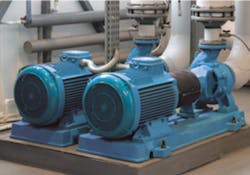Pump Protection—A Thermal Flow Switch or a 50-hp Pump Motor?
The running of pumps is an energy-intensive process that can account for over 10 percent of plant energy costs. Similar to thermal mass flow meters, there are thermal switches available for on/off-type applications for both liquids and gases. A thermal switch can be used to verify flow through the pump and ensure pump seals don’t run dry. A thermal switch can detect not only dry run, but also monitor for low-flow conditions, which can result in pump cavitation and subsequent damage. When you consider the cost of replacing a 50-hp pump motor ($5,000 to $10,000), a $1,000 thermal flow switch can be well worth the investment for pump protection applications. (Photo courtesy Magnetrol International)
Running pumps in a dry state can damage parts and cause cavitation, resulting in thousands of dollars in cost for replacement parts. And these costs don’t even consider inefficiencies in pump operation or downtime that affects production.
There are a number of technologies that can be employed to protect pumps from inefficient and potentially damaging operation. Among them are flow meters and flow switches. However, continuous flow measurement is not always needed for pump protection, and since flow meters typically cost more than flow switches, here we’ll consider the flow switch option in more detail.
Both positive displacement and centrifugal pumps have performance curves to maximize efficiency. There is an ideal combination of differential head and flow rate that will provide the best results. If monitoring the differential head, a thermal flow switch can be set up to shut the pump down when it is operating below the ideal flow rates. Worst case scenario, the thermal switch is installed to verify there is liquid flow to prevent wear, eventual replacements and downtime.
Installing the thermal switch in the suction or discharge piping is acceptable. However, it is important to install in a location where the sensor tip will see liquid movement (in case of a partially filled pipe). When field calibrated, which is most often the case for thermal switches, it is not necessary to install at the centerline of the pipe. As long as the probe is far enough into the pipe to see liquid movement, then it will provide repeatability at the given flow rate. A quarter to half way into the pipe is common.
Installing a few diameters away from the pump will reduce excess turbulence. Turbulence may cause the switch to see higher flow rates than what is actually occurring inside of the pipe. Movement of liquid due to turbulence can theoretically create as much heat transfer as the liquid flow itself. The aforementioned current output is a helpful diagnostic feature in more difficult installations.
Thermal dispersion switches are used in pump protection applications ranging from standard water to high viscosity liquids.
There are unique sensor designs for each individual application, including the popular spherical tip, low-flow bodies and high-temperature/pressure probes. The multitude of probes combined with advanced electronics make thermal-dispersion switches the most competitive technology on the market for pump protection.
This content is sponsored by Magnetrol International. Sponsored content is authorized by the client and does not necessarily reflect the views of the Process Flow Network editorial team.



